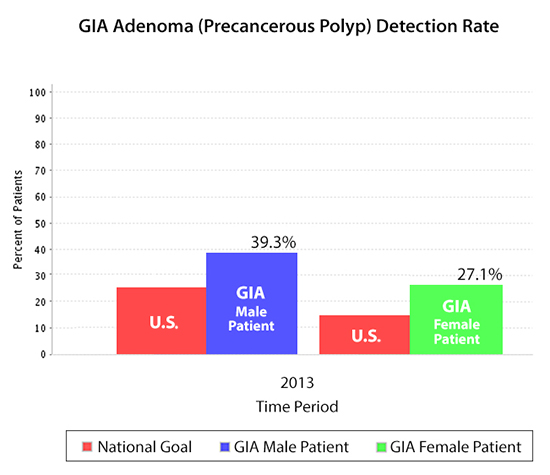When faced with the need for surgery, many people will seek advice from friends, family and other doctors before settling on a surgeon, but few patients are as diligent when it comes to choosing the physician who performs their colonoscopy. Does it matter? Very much so.
The most common precursor of colon cancer is a type of polyp called an adenoma – which is the most common type of colon polyp. Adenomas are detected and removed during colonoscopy. It stands to reason that the better a physician is at detecting and removing adenomas, the less likely his or her patient is to develop colon cancer. A recent study backs up that assertion.
As reported in the New England Journal of Medicine, your risk of developing colon cancer is affected by your doctor’s ability to detect adenomas during colonoscopies. In fact, researchers found that for every 1 percent increase in a physician’s adenoma detection rate or ADR, the patient’s risk of developing colorectal cancer over the next decade dropped by 3 percent, or a 3-to-1 ratio. Given that significant impact, Dr. Douglas Corley, a gastroenterologist at Kaiser Permanente inOakland,Calif., who led the study, believes that adenoma detection rates should be a quality-of-care measure reported to Medicare and made widely available to the public.
Certainly, it is important that patients consider physicians’ adenoma detection rates when deciding who will perform their colonoscopy. The national benchmark for detection is set at 20 percent (that means that adenomas are found and removed in 20 percent of patients). Here at Gastrointestinal Associates, our group average detection rate is 32 percent. Considering the significant impact of even a 1 percent increase in the detection rate, the fact that we are beating the national benchmark by 12 percent is a significant accomplishment and one of which we are very proud.
Dr. Lawrence Kim, who serves as the community private practice councilor for the American Gastroenterological Association (AGA) has stated that a “good” ADR is 25 percent in men or 15 percent in women (adenomas are more common in men). For the year 2013, GIA’s ADR was 39.3 percent for men and 27.1 percent for women. Read more about GIA’s quality metrics here.
As stated in a recent blog post and news items, research shows that screening colonoscopies are saving lives. Now, we know the value of your colonoscopy clearly hinges on your physician’s ability to detect and remove precancerous growths before they grow into something more dangerous. All of GIA’s physician specialists who perform colonoscopies exceed the national benchmark individually, as well as a group. When planning for a colonoscopy for yourself or a family member, it would behoove you to first determine your physician’s adenoma detection rate (ADR) before scheduling this important and potentially life-saving procedure.


